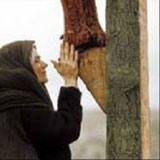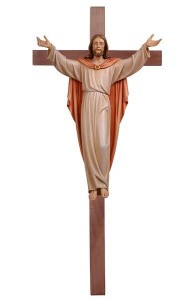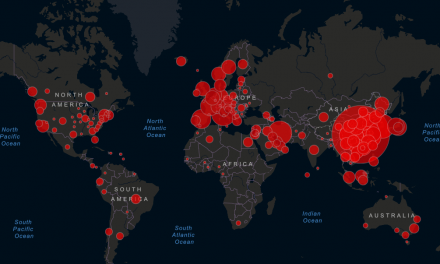One of my parishes is building a new parish school.
One task before the principal is to furnish the school with Christian images and symbols.
He advises that the Establishment has moved away from crucifixes because it distresses some children.
Many schools have an image of the risen Jesus sort of floating in front of the cross:
Neither of us were very keen on that idea because it too obviously sanitises one of the most important parts of our faith. We’ll probably end up with images of Jesus the Good Shepherd, or maybe the Holy Family.
That conversation raises something interesting though. The crucifix is perhaps the preeminent image in our Catholic tradition. Most of us would have a crucifix in the home. The crucifix certainly has a prominent place in this church, and in every Catholic church.
Why the crucifix? Why not the resurrection?
I think today’s Gospel answers that question. It starts with some Greek-speaking visitors to Jerusalem who would like to meet Jesus. The Lord’s response to this request is unexpected.
He could have said, “Sure, introduce us.” But instead he launches into a long discourse about the hour of the Son of Man. It comes across as an elaborate refusal. The visitors, it seems, are rebuffed — until we get to his conclusion:
“And when I am lifted up from the earth,
I shall draw all men to myself.”
So in the end, the Lord is actually granting their request to see him. Jesus in fact wants everyone to find him; to know him and love him on the cross.
It’s no accident that the crucifix looms so large in Catholic imagery. It’s in direct response to today’s Gospel. The crucifix is the great revelation of the heart of God. It exposes a heart blazing with so much love that it is pierced for our sake; it stops beating for our sake. God dies for our sake.
The Lord wants us to approach him on the cross. It is from there that he draws us to himself. Some time or other, you fill find yourself there, at the foot of the cross.
It is desolate, but it is not peaceful. It resembles the eye of a diabolical storm. You might be conscious of hellish howls; frightful thoughts; violent passions. But the predominant feature of Calvary is an oppressive absence of God. Abandonment. The foot of the cross is dark. There is no light; no warmth; no reprieve.
You will pray to God, and to the saints, for the saints are there, surrounding Our Lady, and St John, and St Mary Magdalene. But the more you pray to them for help, the more they will lift and press you into that cross, against its splinters and sharp edges. You may cry out in pain, but they are apparently indifferent.
Why does it happen? Because Jesus is on that cross, and they are lifting you up towards him.
“When I am lifted up from the earth,
I shall draw all men to myself.”
This is a great privilege he gives us: to share his cross. But it is as painful for us as it was for him.
It is a shame that the crucifix is increasingly banished from many Catholic schools (not to mention Catholic hospitals). However, I think the reasons for it are substantial.
There are some students who might be distressed by the image of Jesus, nailed to the cross. I’m conscious that there are some little ones who are very wary — even frightened — by the two angels in our church hall!
The fact is, in most of my parish schools, there is a large crucifix in a prominent position at the school entrance. But it’s also a fact that for some of our students, school is the only place where they find safety and stability.
Warmth, security, affection — these are precisely the qualities our Church should provide, because these are the qualities of the heart of God. The heart we see on the cross.







Great post Father!!
But It all comes down to EDUCATION.
Should we take down multiplication charts because some children get distressed over recalling multiplication facts? Should we take down the “project compassion” posters or other images we have of children living in poor circumstances? Many teachers plaster their classroom walls with such images to promote social justice. Do we take those away as well? Last time I checked, it was our job, as teachers, to educate children.
Taking away crucifixes takes away teaching moments. Instead, we need to expose our children to the truths of our faith. As teachers, this is our responsibility. Rather than taking them down, shouldn’t we be educating them instead?
I can say this from first hand experience; children are not distressed by the cross any more than adults are. There is something absolutely distressing about a man nailed to a cross. I do tell the children that Jesus died… But my next sentence is: how incredible is it, that three days later he was alive again!!! I do not advocate we have classrooms focussed on death, evil, horror or pain. But as teachers we need to speak of the Paschal Mystery as a whole. The paschal mystery does not end with the crucifixion, rather this is where it begins. It ends with hope, with the resurrection! If we deny teaching our children about the crucifix, we’re unable to teach them about the resurrection.
To prove that children are ok with the cross, I share this story from a class of 6-yr olds I taught. One child asked, “I just don’t understand why the good shepherd had to die?” Before I could reply, her fellow student interrupted “what do you mean, you don’t understand? Of course he had to die, because he lays down his life for his sheep. And there needed to be blood because blood is red, and red is the colour of love. His death shows us he loves us.” From the mouths of babes!
Father, GREAT idea to have an image of the Good Shepherd. But don’t hesitate to have crucifixes in each room, just make sure the teachers teach the children that it didn’t end with death. He did rise three days later. We proclaim this truth in our creed! The crucifixes will actually help the teachers teach a truth of our faith.
Those comments that the cross be removed and replaced with something more friendlier is to be expected into todays liberal thinking society, that everything is ok and lets not offend or hurt anyone, interesting enough under communism the first thing which was removed from public view was the crucifix, it was a threat to communism. Measures to destroy the family unit was also put in place, but thats another story. In in my earliest youth I loved and respected the cross, nothing could be further from the truth that the cross distresses or upsets, just look at the violence on tv, video games and in music, that is ok, the cross is deemed not, Its disappointing that our priest just go with the flow and not speak up on basic church values, shame. Marcus
Hi Fr John,
Great post. I think not installing crucifixes would be an injustice to the children, because as you say, we are all going to have times in our lives when everything seems dark, and where there is no reprieve, but we can all take comfort in the fact that Our Lord has been to that place first and He has experienced all our pain, anger etc.
Trying to sanitise our faith and pretend that things are always ‘happy’ reminds me of a time I attended a Mass before school (I was a teacher). At the time, we had received some difficult news about my husband’s health and I was crying in a little ball at the back of the Church when suddenly, I was forced to stand up at the altar (with the 7 or 8 others at Mass ), hold hands and pretend the world was a happy place.
Having the image of the crossed ‘drilled -in’ to our psyche’s has never damaged anyone, yes it’s distressing, but also beautiful – that is the love Our Lord had for me! (and you, and you!!). This is such an important lesson for our young people.
I will pray that the principle has second thoughts!!
Thanks for the story Father John. Don’t let the establishment bother you.
There is always room for Crucifix & Resurrection. As there is a central one at Church, having one in school does not increase any trauma.
Some European shrines have 15 stations, the last being the Resurrection.
God bless you Father